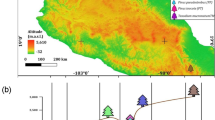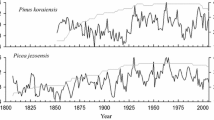Abstract
Hot droughts, droughts attributed to below-average precipitation and exceptional warmth, are increasingly common in the twenty-first century, yet little is known about their effect on coniferous tree growth because of their historical rarity. In much of the American West, including California, radial tree growth is principally driven by precipitation, and narrow ring widths are typically associated with either drier or drought conditions. However, for species growing at high elevations (e.g., Larix lyalli, Pinus albicaulis), growth can be closely aligned with above-average temperatures with maximum growth coinciding with meteorological drought, suggesting that the growth effects of drought span from adverse to beneficial depending on location. Here, we compare radial growth responses of three high-elevation old-growth pines (Pinus jeffreyi, P. lambertiana, and P. contorta) growing in the San Jacinto Mountains, California, during a twenty-first-century hot drought (2000–2020) largely caused by exceptional warmth and a twentieth-century drought (1959–1966) principally driven by precipitation deficits. Mean radial growth during the hot drought was 12% above average while 18% below average during the mid-century drought illustrating that the consequences of environmental stress exhibit spatiotemporal variability. We conclude that the effects of hot droughts on tree growth in high-elevation forests may produce responses different than what is commonly associated with extended dry periods for much of western North America’s forested lands at lower elevational ranges and likely applies to other mountainous regions (e.g., Mediterranean Europe) defined by summer-dry conditions. Thus, the climatological/biological interactions discovered in Southern California may offer clues to the unique nature of high-elevation forested ecosystems globally.

Similar content being viewed by others
Data Availability
Data from this study are available from the corresponding author upon reasonable request.
References
Breshears DD, Fontaine JB, Ruthrof KX, Field JP, Feng X, Burger JR, Law DJ, Kala J, Hardy GESJ (2021) Underappreciated plant vulnerabilities to heat waves. New Phytol 231:32–39. https://doi.org/10.1111/nph.17348
Camarero JJ, Campelo F, Colangelo M, Valeriano C, Knorre A, Solé G, Rubio-Cuadrado Á (2022) Decoupled leaf-wood phenology in two pine species from contrasting climates: longer growing seasons do not mean more radial growth. Agric For Meteorol 327:109223. https://doi.org/10.1016/j.agrformet.2022.109223
Cheng L, Hoerling M, Liu Z, Eischeid J (2019) Physical understanding of human-induced changes in US hot droughts using equilibrium climate simulations. J Climate 32:4431–4443. https://doi.org/10.1175/JCLI-D-18-0611.1
Chiang F, Mazdiyasni O, AghaKouchak A (2021) Evidence of anthropogenic impacts on global drought frequency, duration, and intensity. Nat Commun 12:2754. https://doi.org/10.1038/s41467-021-22314-w
Cook ER, Krusic PJ (2005) Program ARSTAN: a tree-ring standardization program based on detrending and autoregressive time series modeling, with interactive graphics. Lamont-Doherty Earth Observatory, Columbia University, Palisades, NY
De Boeck HJ, Dreesen FE, Janssens IA, Nijs I (2011) Whole-system responses of experimental plant communities to climate extremes imposed in different seasons. New Phytol 189:806–817. https://doi.org/10.1111/j.1469-8137.2010.03515.x
De Boeck HJ, Verbeeck H (2011) Drought-associated changes in climate and their relevance for ecosystem experiments and models. Biogeosciences 8(5):1121–1130. https://doi.org/10.5194/bg-8-1121-2011
Diaz HF (1983) Drought in the United States. J App Met Clim 22(1):3–16. https://doi.org/10.1175/1520-0450(1983)022<0003:DITUS>2.0.CO;2
Dong C, MacDonald GM, Willis K, Gillespie TW, Okin GS, Williams AP (2019) Vegetation responses to 2012–2016 drought in Northern and Southern California. Geophys Res Lett 46:3810–3821. https://doi.org/10.1029/2019GL082137
Fettig CJ, Mortenson LA, Bulaon BM, Foulk PB (2019) Tree mortality following drought in the central and southern Sierra Nevada, California, U.S. For Ecol Manage 432:164–178. https://doi.org/10.1016/j.foreco.2018.09.006
Gangopadhyay S, Woodhouse CA, McCabe GJ, Routson CC, Meko DM (2022) Tree rings reveal unmatched 2nd century drought in the Colorado River Basin. Geophys Res Lett 49:e2022GL098781. https://doi.org/10.1029/2022GL098781
Goulden ML, Bales RC (2019) California forest die-off linked to multi-year deep soil drying in 2012–2015 drought. Nat Geosci 12:632–637. https://doi.org/10.1038/s41561-019-0388-5
Holmes RL (1983) Computer-assisted quality control in tree-ring dating and measurement. Tree-Ring Bull 43:69–78
Keen RM, Voelker SL, Bentz BJ, Wang SYS, Ferrell R (2020) Stronger influence of growth rate than severity of drought stress on mortality of large ponderosa pines during the 2012–2015 California drought. Oecologia 194:359–370. https://doi.org/10.1007/s00442-020-04771-0
Keen RM, Voelker SL, Wang SYS, Bentz BJ, Goulden ML, Dangerfield CR et al (2022) Changes in tree drought sensitivity provided early warning signals to the California drought and forest mortality event. Glob Chang Biol 28(3):1119–1132. https://doi.org/10.1111/gcb.15973
Kempes CP, Myers OB, Breshears DD, Ebersole JJ (2008) Comparing response of Pinus edulis tree-ring growth to five alternate moisture indices using historic meteorological data. J Arid Environ 72(4):350–357. https://doi.org/10.1016/j.jaridenv.2007.07.009
Kerhoulas LP, Kolb TE, Koch GW (2017) The influence of monsoon climate on latewood growth of southwestern ponderosa pine. Forests 8(5):140. https://doi.org/10.3390/f8050140
Kichas NE, Pederson GT, Hood SM, Everett RG, McWethy DB (2023) Increased whitebark pine (Pinus albicaulis) growth and defense under a warmer and regionally drier climate. Front For Glob Change 6:1089138. https://doi.org/10.3389/ffgc.2023.1089138
Knapp PA, Soulé PT (2011) Reconstructing annual area burned in the northern Rockies, USA: AD 1626–2008. Geophys Res Lett 38:L17402. https://doi.org/10.1029/2011GL048119
Ma F, Yan Y, Svenning JC, Quan Q, Peng J, Zhang R et al (2023) Opposing effects of warming on the stability of above-and belowground productivity in facing an extreme drought event. Ecology e4193. https://doi.org/10.1002/ecy.4193
Madakumbura GD, Goulden ML, Hal A, Fu R, Moritz MA, Koven CD, Kueppers LM, Norlen CA, Randerson JT (2020) Recent California tree mortality portends future increase in drought-driven forest die-off. Environ Res Lett 15:124040. https://doi.org/10.1088/1748-9326/abc719
Montpellier EE, Soulé PT, Knapp PA, Maxwell JT (2019) Dendroclimatic assessment of ponderosa pine radial growth along elevational transects in western Montana, USA. Forests 10(12):1094. https://doi.org/10.3390/f10121094
Overpeck JT (2013) The challenge of hot drought. Nature 503:350–351. https://doi.org/10.1038/503350a
Palmer WC (1965) Meteorological drought, vol 30. US Department of Commerce, Weather Bureau
Prugh LR, Deguines N, Grinath JB, Suding KN, Bean WT, Stafford R, Brashares JS (2018) Ecological winners and losers of extreme drought in California. Nat Clim Change 8:819–824. https://doi.org/10.1038/s41558-018-0255-1
Robinson W, Kerhoulas LP, Sherriff RL, Roletti G, van Mantgem PJ (2023) Drought survival strategies differ between coastal and montane conifers in northern California. Ecosphere 14:e4480. https://doi.org/10.1002/ecs2.4480
Sanmiguel-Vallelado A, Camarero JJ, Moran-Tejeda E, Gazol A, Colangelo M et al (2021) Snow dynamics influence tree growth by controlling soil temperature in mountain pine forests. Agric For Meteorol 296:108205. https://doi.org/10.1016/j.agrformet.2020.108205
Seaton S, Matusick G, Ruthrof KX, Hardy GESJ (2015) Outbreak of Phoracantha semipunctata in response to severe drought in a Mediterranean Eucalyptus forest. Forests 6(11):3868–3881. https://doi.org/10.3390/f6113868
Soulé PT (1992) Spatial patterns of drought frequency and duration in the contiguous USA based on multiple drought event definitions. Int J Climatol 12:11–24. https://doi.org/10.1002/joc.3370120103
Soulé PT, Knapp PA (2024) The evolution of “Hot” droughts in Southern California, USA from the 20th to 21st century. J Arid Environ 220:105118. https://doi.org/10.1016/j.jaridenv.2023.105118
Stokes MA, Smiley TL (1996) An introduction to tree-ring dating. University of Arizona Press, Tucson
Tran TJ, Bruening JM, Bunn AG, Salzer MW, Weiss SB (2017) Cluster analysis and topoclimate modeling to examine bristlecone pine tree-ring growth signals in the Great Basin, USA. Environ Res Lett 12(1):014007. https://doi.org/10.1088/1748-9326/aa5388
Udall B, Overpeck J (2017) The twenty-first century Colorado River hot drought and implications for the future. Water Resour Res 53:2404–2418. https://doi.org/10.1002/2016WR019638
Vaganov EA, Hughes MK, Kirdyanov AV, Schweingruber FH, Silkin PP (1999) Influence of snowfall and melt timing on tree growth in subarctic Eurasia. Nature 400(6740):149–151. https://doi.org/10.1038/22087
Williams AP, Cook ER, Smerdon JE, Cook BI, Abatzoglou JT, Bolles K, Baek SH, Badger AM, Livneh B (2020) Large contribution from anthropogenic warming to an emerging North American megadrought. Science 368(6488):314–318. https://doi.org/10.1126/science.aaz9600
Williams AP, Cook BI, Smerdon JE (2022) Rapid intensification of the emerging southwestern North American megadrought in 2020–2021. Nat Clim Change 12:232–234. https://doi.org/10.1038/s41558-022-01290-z
Young DJ, Stevens JT, Earles JM, Moore J, Ellis A, Jirka AL, Latimer AM (2017) Long-term climate and competition explain forest mortality patterns under extreme drought. Ecol Lett 20:78–86. https://doi.org/10.1111/ele.12711
Acknowledgements
This project was made possible by internal funding from a University of North Carolina Greensboro Faculty First Grant and a University Research Council grant at Appalachian State University. We are grateful for the support of Ken Kietzer of the California State Parks system for helping facilitate the permitting process, Stephen James and other staff at the Long Valley Ranger Station at Mt. Jacinto State Park for providing climate data and information about the forest ecosystem, and Tim Jones of the Palm Springs Aerial Tramway for providing complimentary tram passes so that we could access the study site. Lastly, this manuscript benefitted substantially from the input of three external reviewers who offered constructive feedback and we are thankful for their help.
Author information
Authors and Affiliations
Corresponding author
Rights and permissions
Springer Nature or its licensor (e.g. a society or other partner) holds exclusive rights to this article under a publishing agreement with the author(s) or other rightsholder(s); author self-archiving of the accepted manuscript version of this article is solely governed by the terms of such publishing agreement and applicable law.
About this article
Cite this article
Knapp, P.A., Soulé, P.T., Mitchell, T.J. et al. Increasing radial growth in old-growth high-elevation conifers in Southern California, USA, during the exceptional “hot drought” of 2000–2020. Int J Biometeorol 68, 743–748 (2024). https://doi.org/10.1007/s00484-024-02619-3
Received:
Revised:
Accepted:
Published:
Issue Date:
DOI: https://doi.org/10.1007/s00484-024-02619-3




